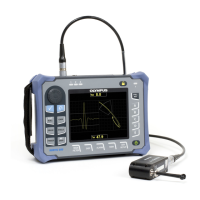DMTA-10040-01EN, Rev. E, February 2018
Using the Instrument 251
5.4.2 ECT Erosion and Corrosion — NORTEC 600D Model
In this application, an absolute configuration is used to identify volumetric or gradual
defects such as erosion and corrosion in nonferromagnetic alloys. An example of an
absolute signal response is shown in Figure 5-182 on page 251. (For a general
explanation of ECT technology, see “ECT Pitting, Wear, and Cracks — NORTEC 600D
Model” on page 230.)
Figure 5‑182 An example of an ECT absolute signal response
This application uses inspection materials similar to the example illustrated in
Figure 5-135 on page 216 (in the application “Inspecting Heat Exchanger Tubing
Using Dual Frequency — NORTEC 600D Model” on page 215).
The following products are used in this procedure:
• Eddy current bobbin probe for heat exchanger tubing: absolute/differential,
14.8 mm (0.583 in.) diameter, 15 kHz center frequency, 20 m (65.6 ft) cable;
P/N: TEA-148-015-N05 [U8282109]
• Differential and absolute eddy current probe adaptor; P/N: CBAS-10818-0001
[Q7670051]
• Admiralty brass calibration standard: OD 19 mm (0.75 in.), WT (wall thickness)
1.65 mm (0.065 in.); P/N: CT02-001-D16 [U8779241]
• Convenient, highly recommended items (however, not mandatory): foot switch
(P/N: 9522333 [Q7670007]), foot switch armored cable (P/N: 9122404 [Q7670008]),
and foot switch adaptor (P/N: 9522336 [Q2500083])
To set the initial NORTEC 600 configuration
1. Connect the adaptor, probe, and foot-switch adaptor cable to the PROBE
connector on the NORTEC 600.

